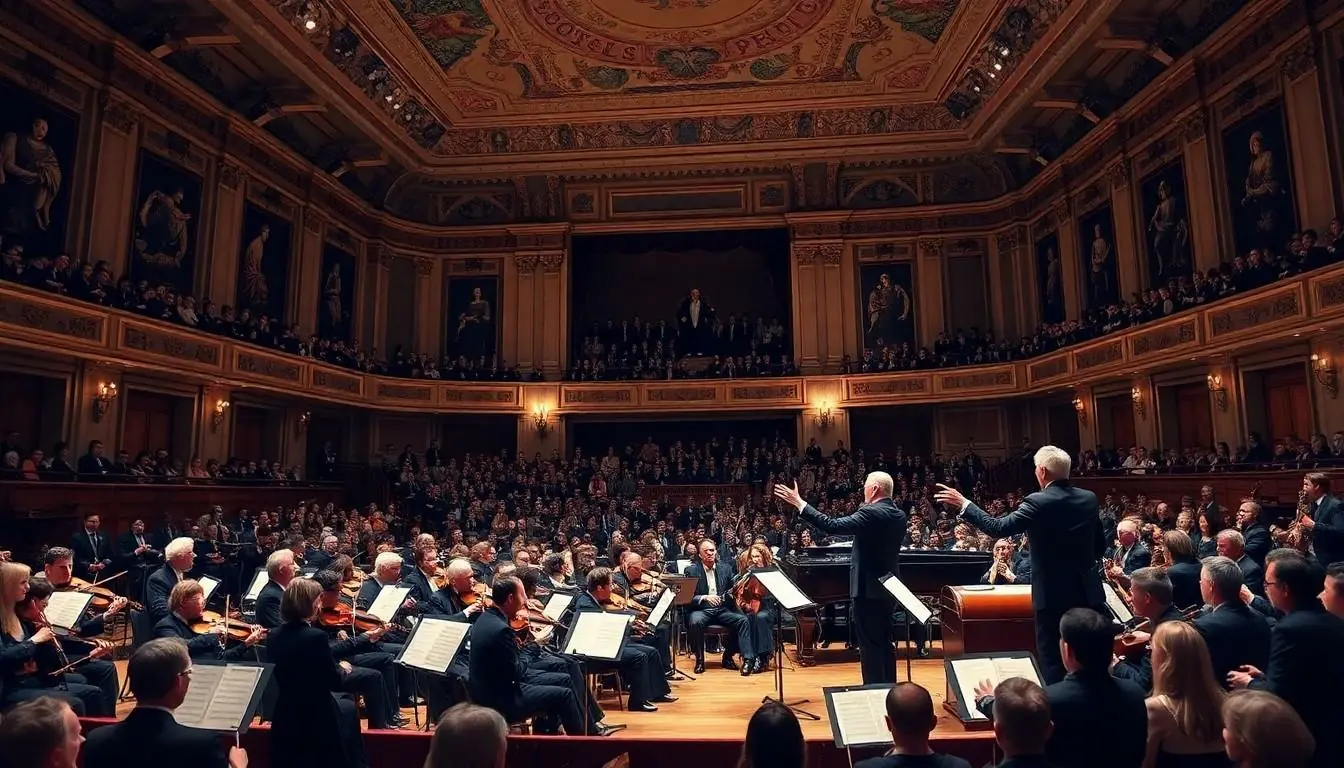Imagine a world where Mozart and Madonna collide in a symphonic explosion of sound. That’s the magic of classical pop music, where timeless melodies meet modern rhythms. It’s like a musical buffet where everyone can find something to savor, whether you’re a fan of soaring strings or infectious pop hooks.
Table of Contents
ToggleOverview of Classical Pop Music
Classical pop music blends the elegance of classical compositions with modern pop sensibilities. This genre features orchestral arrangements combined with contemporary songwriting, creating a unique sound that attracts diverse audiences. Fans of both classical and pop genres appreciate its rich textures and catchy melodies.
Renowned artists such as André Rieu and Il Divo exemplify successful integration of classical and pop styles. Their music showcases lush strings, harmonized vocals, and accessible lyrics. Collaborations between classical musicians and pop stars often produce chart-topping hits, further blurring genre boundaries.
This genre also thrives in crossover albums, where traditional symphonic elements meet mainstream appeal. Examples include Josh Groban’s renowned recordings, which highlight powerful vocal performances alongside sweeping orchestral backdrops. These projects illustrate the potential for high art to reach wider audiences.
Many listeners enjoy classical pop for its emotional depth and theatrical flair. The combination of sophisticated composition and mainstream accessibility resonates well, making it a popular choice for various settings, such as weddings, concerts, and formal events. Such occasions frequently call for a soundtrack that captivates while remaining universally pleasing.
Moreover, classical pop music’s appeal extends beyond mere enjoyment. It often introduces new listeners to classical music, sparking interest in orchestral compositions. This cross-pollination can lead to greater appreciation for both genres, showcasing the versatility of musical expression. As classical pop continues to evolve, it redefines traditional music boundaries, crafting an enduring legacy that promotes appreciation across diverse audience demographics.
History of Classical Pop Music
Classical pop music blends elements from both classical and contemporary pop genres. This fusion creates a unique auditory experience appealing to diverse audiences.
Origins and Influences
Origins trace back to the early 20th century when composers like George Gershwin began merging classical and jazz influences. Artists embraced classical techniques while incorporating popular music elements, creating a unique sound. Influences from operatic traditions and theatrical performances played a significant role in shaping this genre. The British Invasion in the 1960s brought orchestral arrangements into mainstream pop, further enriching the evolution of classical pop music.
Key Developments Over the Years
Key developments include the rise of crossover artists since the 1990s, who introduced classical vocal styles to pop audiences. Albums by figures like Andrea Bocelli and Il Divo showcased the commercial viability of classical pop, yielding chart success and mainstream recognition. The genre has seen orchestral elements integrated into modern pop productions, transforming the musical landscape. Collaborations between classical musicians and pop stars have produced memorable hits, expanding the genre’s reach and appeal. Each decade has seen further experimentation, allowing classical pop to thrive and evolve continuously.
Notable Classical Pop Artists
Classical pop music showcases numerous talented artists who excel in blending classical elements with popular sounds. Renowned figures elevate the genre by infusing their unique styles and captivating performances.
Iconic Performers
André Rieu captivates audiences worldwide with his enchanting orchestral performances. Known for his charismatic presence and engaging concerts, he brilliantly combines classical melodies with popular tunes. Il Divo, a multi-national vocal group, stands out for their harmonious blend of operatic and pop music. Their powerful performances and emotional delivery resonate deeply with listeners. Josh Groban, famed for his rich tenor voice, frequently collaborates with orchestras, delivering heartfelt ballads that bridge classical and contemporary genres. These artists, among others, have significantly shaped classical pop, making it accessible and appealing.
Emerging Talents
New talents continually emerge within the classical pop realm, expanding its reach and influence. For instance, 19-year-old soprano Laura Bretan, a semi-finalist on America’s Got Talent, captivates audiences with her extraordinary vocal range and blend of classical training with pop sensibilities. Singer-songwriter Aidan O’Rourke infuses modern pop elements into his classical influences, creating a fresh sound that appeals to younger audiences. British mezzo-soprano Kye Hwa focuses on innovative interpretations of pop classics, garnering attention and praise for her unique style. These emerging artists contribute to the genre’s evolution and ensure its relevance in today’s musical landscape.
Characteristics of Classical Pop Music
Classical pop music uniquely blends classical melodies with contemporary pop elements. This genre showcases distinct characteristics that appeal to diverse audiences.
Melodic Structure
Melodic structure in classical pop music often reflects classical traditions. Catchy hooks paired with lyrical phrasing enhance memorability. Frequent use of sweeping melodies evokes strong emotions. Repetition creates a familiar musical experience. Harmonies may draw from classical sources, enriching the overall sound. Various scales, including major and minor, contribute to the emotional depth present in many compositions. Listeners often find themselves easily moved by this genre’s captivating tunes.
Instrumentation and Arrangement
Instrumentation and arrangement play crucial roles in classical pop music. Orchestral elements, such as strings, brass, and woodwinds, are prominently featured. Various instruments intertwine to produce lush soundscapes. Collaborations between different musicians add layers to the arrangement. Traditional classical techniques, like counterpoint, enhance the richness of the sound. Melodic and rhythmic interplay creates a dynamic listening experience. Use of modern pop instruments, like electric guitar and synthesizers, introduces a contemporary flair. Overall, this thoughtful orchestration results in a polished and engaging genre.
The Fusion of Genres
Classical pop music exemplifies a remarkable blend of genres, integrating timeless classical melodies with contemporary pop rhythms. Artists creatively fuse various elements from both worlds.
Classical Elements in Pop Music
Classical music contributes intricate melodies and sophisticated structures to pop music tracks. Orchestration often features strings, brass, and woodwinds, enriching the listening experience. Many pop songs utilize classical techniques, such as counterpoint and thematic development, to create depth and complexity. Notable examples include songs by artists like Josh Groban and Il Divo, who embrace traditional orchestral arrangements. Familiar hooks frequently draw from classical themes, making them memorable for audiences. This fusion enhances pop music while introducing classical nuances, inviting a broader demographic to appreciate the depth of classical influences.
Pop Influences in Classical Music
Pop music has increasingly seeped into the classical genre, driving innovation and attracting diverse audiences. Adaptations often highlight modern rhythms and contemporary harmonies in classical compositions. Orchestral arrangements may incorporate widely recognized pop songs, creating excitement through familiar sounds. Artists like Andrea Bocelli and Il Divo exemplify this trend, merging operatic vocal techniques with popular music styles. Crossover performances often blend classical instrumentation with catchy melodies, ensuring accessibility. This intermingling fuels genre evolution while fostering a fresh appreciation for both classical and pop traditions in the music landscape.
Classical pop music stands as a vibrant testament to the power of musical fusion. It invites listeners from diverse backgrounds to experience the beauty of classical melodies intertwined with contemporary pop rhythms. This genre not only entertains but also educates audiences about the richness of orchestral music, bridging gaps between generations.
As classical pop continues to evolve through innovative collaborations and emerging talents, its influence remains undeniable. The genre’s ability to evoke deep emotions while maintaining accessibility ensures its place in both modern music and timeless celebrations. With each new artist and album, classical pop is set to enchant even more listeners, solidifying its legacy in the musical landscape.



